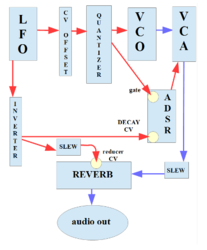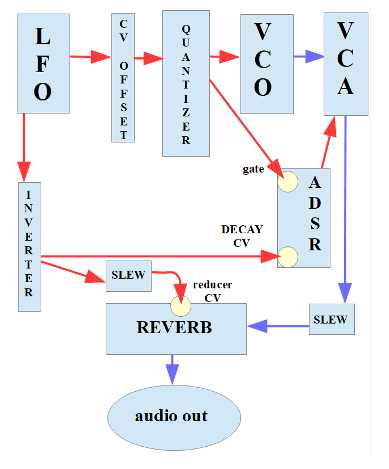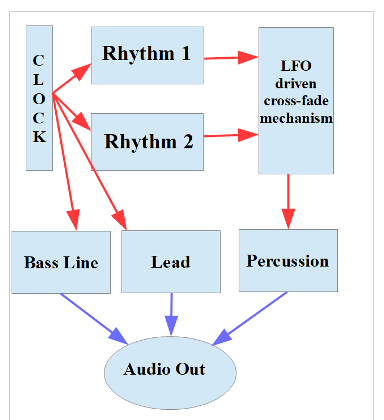Thoughts on Generative Music - Part 10

Thoughts on Generative Music - Part 10
(contains embedded video – there are VCV rack presets mentioned in the text here and there. Owners of my book, this article is an excerpt from, will get the link to those presets. More about my book here: https://www.dev.rofilm-media.net/node/331) If you want to support my work, please make use of the "PayPal" button - thank you very much indeed!
Chapter 3.3:
Specific Compositional Techniques
This chapter is not at all meant to deliver a conclusive enumeration, but rather talks about and shows some especially remarkable and useful techniques.
Chapter 3.3.1:
Pitch Dependency
I talked about relations between normally independent sonic parameters in the last chapter. A quite special relation is pitch dependency of parameters. There are a couple of ways to establish pitch dependency. The preset “pitchdependency.vcv” and the video behind the following link show one of them, a way which you should be able to go whatever system or modules you are using. In the example the length of the notes as well as the amount of reverb depend on the pitch of the note. The higher the notes pitch the shorter they are, but the more reverb is added. The lower the pitch of the notes is, the longer the notes are, and the less reverb is added. The block diagram shows the systematic, and the video behind the following link demonstrates the patch.

Chapter 3.3.2:
Rhythm
An interesting way to deal with rhythm is to cross-fade two basically different rhythms, but sustaining the melodic parts of the piece (bass line, lead etc.).
Each of the different rhythms interprets these sustained melodic elements in its own way, and in the middle of the cross-fade process, when both rhythms are audible, we get interesting rhythmical side effects.
The patch “patternmerge.vcv” and the video behind the following link demonstrate this compositional technique. In this example the lead line changes its timbre parallel to the changes of the underlying rhythm – its timbre, not the melody itself.
The patch could be made a lot smaller by using less but more versatile modules. But for the sake of system compatibility I have decided to set it up with a couple of individual modules.
And there is another aspect of using more modules, each of which having not that many functions, instead of using less but very versatile modules equipped with a bunch of functions:
You get more patch points to intervene!
With rather basic modules each function of the module is mostly equipped with a CV input jack, whereas “larger” modules, which offer a whole lot of functions commonly allow only some of them to be modulated by external CV, whereas the parameters of the other functions need to be set with knobs plus menu diving. Well, back to the patch now. The two merging rhythms are a simple 8/8 and a simple 6/6 rhythm. The block schematic shows the general relation of all functional groups of modules.

Another method to hold the listeners attention and add (sonic) colour to our rhythm is to replace (all or some) drum/percussion instruments by wooshes, glitches, clicks, pings etc. and even melodic elements. So, not changing the rhythm but the sonic elements, that build it. It cannot be a matter of this eBook (not at all of this chapter) to go through all the methods to produce interesting sounds of the mentioned kind. This would be a matter of a whole new eBook about designing sounds (and probably will? Next year? Just follow my website and my social media – links in Appendix B).
The video behind the following link shows a little example, where wooshes and glitches and a melody line build a multi-rhythmical pattern. The rhythmical aspects of the melody are not generated by different note lengths and breaks, but by rhythmical changes of the timbre of the instrument.
I have already talked about adding randomness to (poly-)rhythms, so only this short reminder here.
And changing the rhythm of a melody is bread and butter practise when composing, and is not more important in generative music than in any other musical style and way to produce music. So no further explanations needed.
In a world, which is still suffering from the loudness war, which recently tried to devastate the last rests of listeners´ susceptibility for sonic details it may be appropriate to mention, that we can intentionally compose even volume and loudness and their development (not an aspect of rhythm, but not a matter for a chapter of its own either).
Chapter 3.3.3:
Tension and Layers
A special strategy to add and increase tension is adding more and more aspect layers to a musical development.
We can do so by adding voices, e.g. simply doubling a succession of phrases and using different timbres for each new “clone”, or by adding different voices, or by consecutively adding notes to a melody, e.g. starting with a simple phrase of long notes and adding more and more melody building notes while making the note values shorter and shorter. We can add different kinds of layers (leads, different bass lines with different timbres, percussion, chord progressions, a second, third etc. melody line and more).
The preset “layers.vcv” and the video behind the following link show an example of different percussion tracks, a bass line, and a lead.
And the preset “layermelody.vcv” and the video behind the following link show an example only with different melody lines.
to be continued.
to part 1: https://www.dev.rofilm-media.net/node/335
to part 2: https://www.dev.rofilm-media.net/node/343
to part 3: https://www.dev.rofilm-media.net/node/344
to part 4: https://www.dev.rofilm-media.net/node/358
to part 5: https://www.dev.rofilm-media.net/node/365
to part 6: https://www.dev.rofilm-media.net/node/374
to part 7: https://www.dev.rofilm-media.net/node/381
to part 8: https://www.dev.rofilm-media.net/node/386
to part 9: https://www.dev.rofilm-media.net/node/391
to part 11: https://www.dev.rofilm-media.net/node/408
to part 12: https://www.dev.rofilm-media.net/node/415
to part 13: https://www.dev.rofilm-media.net/node/425
to part 14: https://www.dev.rofilm-media.net/node/427

Add new comment